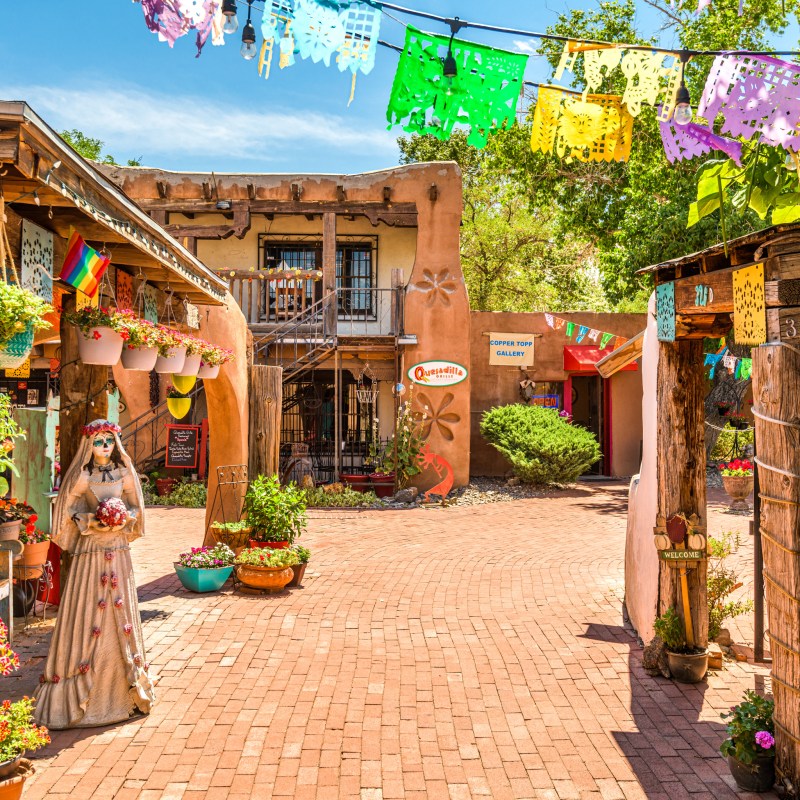
While southern New Mexico offers warm weather and abundant sunshine during the winter months, the higher elevations and mountains of northern New Mexico provide cooler temperatures during the summer months.
Videos by TravelAwaits
Northern New Mexico is home to several Native American pueblos and tribes, including the Hopi, Nambe, Navajo, Zia, and Zuni. It was in this part of the Land of Enchantment that the world’s most renowned scientists came together to work on a history-altering secret project that brought World War II to an end. And it was the high desert landscape of northern New Mexico that drew Wisconsin-born artist Georgia O’Keeffe westward for the final three decades of her life.
Fun Fact: Featuring the eye-catching sun sign of the Zia people on a bright yellow background, New Mexico’s flag stands out in a sea of blue backgrounds and state seals. Here’s how a sacred Native American symbol ended up becoming synonymous with the state.
Here’s what to see and do when you explore New Mexico on a road trip from Santa Fe to Gallup.

Santa Fe
Perhaps it’s because American schoolchildren are taught about our nation’s history from a predominantly Anglo-European perspective, but most Americans tend to think about our country “growing up” and expanding from the Atlantic Coast to the Pacific Ocean. So people are often surprised to learn that Santa Fe is the oldest government seat in the United States and home to the oldest church in the nation. Take that, Plymouth Rock!
Before hitting the road, be sure to explore the architectural landmarks, quaint boutiques, and delicious restaurants on the Santa Fe Plaza. Just across Palace Avenue from the historic square is the Palace of the Governors, a single-story adobe building built in the early 1600s to serve as the seat of the government when New Mexico was a Spanish colony.
Head east on the north side of Palace Avenue and pause at 109 East Palace Avenue in the small shopping center. A sign in the back of the gallery recognizes this space as the cover for the administrative office that supported the men and women headed to Los Alamos to work on the Manhattan Project during World War II.
Pro Tip: Before taking this road trip, consider reading the book 109 East Palace: Robert Oppenheimer and the Secret City of Los Alamos. Written by Jennet Conant, the granddaughter of a chemist who oversaw the Manhattan Project, it provides a unique perspective into the people behind the project in a way that even non-scientists will enjoy.
While Santa Fe is well known for its rich history, vibrant art scene, uniquely shaped capitol building, and delicious food, it is not known as a budget destination. However, these tips will help you explore this beautiful city to the fullest while stretching your vacation dollars to the max.

Los Alamos
The Los Alamos History Museum is a must-see attraction in this high-altitude town. And while the town’s name is understandably connected to the development of the atomic bomb, this museum showcases the town’s entire history. You’ll certainly learn more about the brilliant scientists who lived and worked here in the 1940s (don’t miss the exhibit featuring a replica of the gate from Santa Fe’s 109 East Palace and highlighting Dorothy McKibbin, “the gatekeeper of Los Alamos”). But you can also visit an ancestral Pueblo site and step inside a small log cabin constructed during the state’s homestead era.
To learn more about northern New Mexico’s homesteading families, follow this self-guided driving tour.
After the Los Alamos History Museum, cross Central Avenue to the Manhattan Project National Historical Park’s visitor center, where you can pick up a park guide and get a stamp for your National Parks Passport. (This national park site also offers a Junior Ranger booklet for the younger members of your travel group.)
After exploring the center, take a self-guided walking tour through downtown Los Alamos. The route winds past the former icehouse where the first atomic device was assembled, the house where Nobel Prize winners Edwin McMillan and Hans Bethe lived, and the Women’s Army Corps dormitory. You’ll also see Bathtub Row, named for the only homes in town that had bathtubs during World War II.
Wrap up your visit to Los Alamos with a stop at the Bradbury Science Museum. Named for the Los Alamos National Laboratory’s second director, this venue includes roughly 60 interactive exhibits that highlight the lab’s historic and present-day research projects.
Pro Tip: Because the self-guided walking tour ends at the Bradbury Science Museum, consider parking your car there and walking the block to the Manhattan Project National Historical Park.

Bandelier National Monument
Approximately 30 minutes south of Los Alamos, Bandelier National Monument safeguards 33,000 acres of rugged landscape, prehistoric petroglyphs, and wildlife habitat. Take a guided tour to the ruins of the Tyuonyi Pueblo, a massive two-story, 400-room building constructed from volcanic tuff that was once used primarily for storing food.
Or take a hike on one of the monument’s many trails. With easy and moderate trails that range from 1 to 11 miles, you’re sure to find the perfect path to explore the park. Depending on the season, you can also boat, camp, picnic, or cross-country ski when you visit Bandelier National Monument.

Coronado Historic Site
Heading southwest around the Santa Fe National Forest toward Albuquerque, the Coronado Historic Site and the ruins of the Kuaua Pueblo are about 90 miles away from Bandelier. Founded in 1325, Kuaua was home to about 1,200 people when Francisco Vasquez de Coronado showed up unannounced. In search of the fabled Seven Cities of Gold, the Spanish conquistador brought along an army of 2,500 soldiers and Native American allies.
The indigenous people were prosperous farmers, and without the food and supplies they provided to Coronado and his men, the outsiders would have perished. In an all-too-familiar tale, conflict between Coronado and the other Spanish explorers who followed forced the Pueblo tribe to abandon the site. Today, many descendants of the Kuaua people live in the Tiwa-speaking pueblos of Isleta, Picuris, Sandia, and Taos.

Albuquerque
Long known for hosting the world’s largest balloon festival — and more recently for being the setting of Breaking Bad and Better Call Saul — Albuquerque is New Mexico’s largest city. Named for the governor of Spanish colonial New Mexico, the Duke of Alburquerque (no, that extra r isn’t a typo), the Duke City was an important stop on the trade route linking Mexico City with Santa Fe.
Continue exploring the state’s Native American culture, Spanish colonial past, and scientific history with visits to Petroglyph National Monument, the Indian Pueblo Cultural Center, the Old Town, and the National Museum of Nuclear Science & History. Or take in spectacular views of the city from the Sandia Peak Tramway.
Enjoy seasonally inspired Native American cuisine at Pueblo Harvest Cafe or dig into green chile-topped New Mexican favorites at Frontier Restaurant nearly any hour of the day. Don’t get back on the road without trying the biscochitos (New Mexico’s state cookies) at Golden Crown Panaderia.

Grants
Just over an hour’s drive west of Albuquerque, nestled between the dormant Mount Taylor stratovolcano and El Malpais National Monument, is the town of Grants. Learn about the Land of Enchantment’s mining history, including the uranium that fueled the first atomic bomb, with a stop at the New Mexico Mining Museum.

Gallup
The final stop on this New Mexico road trip is Gallup. While this town’s name may immediately conjure up data-driven, insightful polls about everything from poverty to political candidates, the town is actually named after a railroad paymaster, not the global analytics and advice firm.
A majority of Gallup’s residents are Native Americans, so this is the ideal place to learn more about the Navajo code talkers and the important role they played in World War II by touring the special exhibit housed in the McKinley County Chamber of Commerce. During the summer months, Native Americans perform nightly dances in Courthouse Square.
What To Know Before You Go
While the average altitude in New Mexico is about 5,700 feet above sea level, the majority of this road trip is at 6,000 to more than 7,000 feet. An altitude change of as little as 1,000 feet can trigger altitude sickness, so be proactive in managing the altitude change.
From flautas to fajitas, when you order New Mexican cuisine, you’ll be asked the state question, “Red or green?” Your server wants to know if you’d like red chiles or green chiles added to your meal. If you want to try both, simply reply, “Christmas.”
